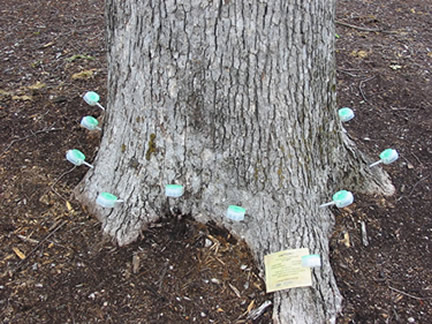Trees of Carolina Fertilization ServicesCall Today! 919-661-7080
Fertilizing a tree can increase growth, reduce susceptibility to certain diseases and pets and can even help reverse declining health. Trees of Carolina uses two methods to fertilize trees.
1. Liquid injection method – fertilizer is dissolved or suspended in water and is injected into the soil using a hydraulic sprayer. The spacing and distribution of the holes area 8-12 inches deep and 2-3 feet on center.
2. Tree Injections – Microinjections are capsules that introduce fertilizers directly into the xellem of the tree. Microinjections rely solely on the transpirational stream to move materials systematically within the xylem. The advantage of injections are the 100% uptake of the material, no run off or leaching and bypassing the root system because of stress from construction damage or soil compaction.

Mulch: Wood chips make excellent landscape mulch. Mulch benefits trees by discouraging weeds from growing, conserving moisture during drought periods and allowing better use of water by controlling runoff and increasing water holding capacity of light. Mulch also helps maintain a uniform soil temperature. A 3 to 4 inch layer of mulch can add to the aesthetic value of your landscape.
Reminder: Do not allow mulch to touch the tree trunk. It should be kept 12 inches back from the trunk of the tree.
We deliver 18 to 20 yard of wood chips at a time for a fee of $25.0
Soil Aeration: Soil aeration is performed usually after construction of a home or building. Ideal soil for root growth and development is about 50 percent pore space. When soil is compacted – many times after construction – the pore space between soil particles is greatly reduced. This reduces oxygen availability to roots and causes accumulation of carbon dioxide and other gases. Soil compaction reduces water infiltration and movement and impairs drainage. Our method of aeration of the root zone involves drilling holes in the ground. The holes are usually 2 inches in diameter and are 1 to 3 feet of center throughout the root zone of the tree. The depth of the holes is 10 to 12 inches deep or deeper if the soil grade has been raised. We then, back fill the holes with organic material to maintain aeration and support root growth.







